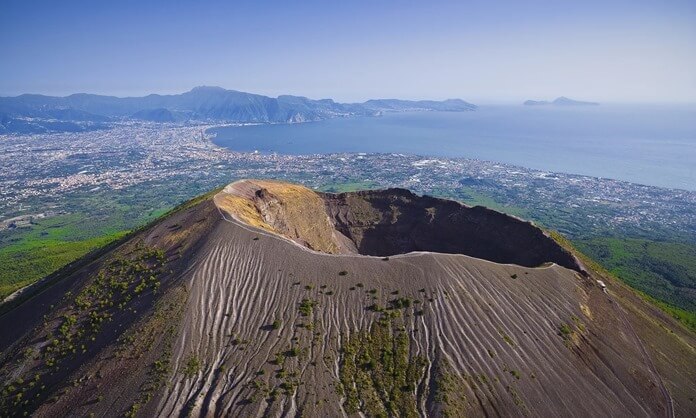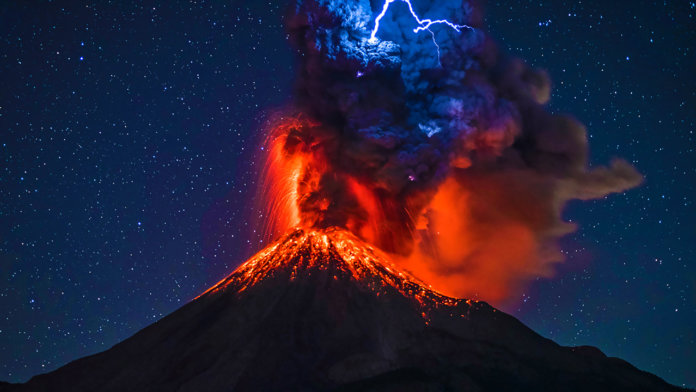Many predictions of the possible end of the world include the eruption of the Yellowstone supervolcano. But even though it is now promoted beyond measure, there are many volcanoes on Earth, which are a time bomb for the nearby human settlements.
And so that your vacation will never be overshadowed by clouds of steam, ash and lava flows, we will tell you about the ten most dangerous volcanoes on Earth, next to which you should definitely not take a selfie.
10. Galeras, Colombia
A stratovolcano with a large caldera is located west of the city of Pasto, and is one of the most active volcanoes in Colombia. It has been active for over one million years and there are no prerequisites for it to calm down in the 21st century.
In 1993, during the eruption of Galeras, nine people died, including six scientists, and in 2010, 9 (according to other sources - 8) thousand people were evacuated from the area near the volcano.
9. Klyuchevskaya Sopka, Russia
A selection of the most dangerous volcanoes on the planet could not do without a representative from Russia. Klyuchevskaya Sopka is one of the highest volcanoes on Earth, and the highest operating on the continent of Eurasia. It is located on the Kamchatka Peninsula, and, surprisingly, is covered with pure snow and ice crusts, which during an eruption can create an interesting contrast with ash and lava flows.
It can throw out a column of ash, reaching a height of 8 kilometers. And it erupts periodically, about once every five years, starting in 1737 (this is only the first of the documented eruptions, and how many of them were before that is unknown). The most powerful of the eruptions occurred in the 19th century.
8. Kilauea, Hawaii
The name of this volcano does not differ in originality, and translated from Hawaiian it means “belching”, “splashing out”. It is believed that it was he who was chosen as her home by the local goddess of volcanoes.
Kilauea is the most active shield volcano on the island, erupting almost continuously from 1983 to 2018, causing a lot of destruction, as well as severe earthquakes and fires.
Since 1912, the Hawaiian Volcanic Brawler has been watched by staff at the Hawaiian Volcanic Observatory.
7. Merapi, Indonesia
Merapi (meaning "mountain of fire") is one of the most active volcanoes in Indonesia, and has erupted for centuries. It is located near the center of Java, about 32 kilometers north of Yogyakarta city.
One of the largest recorded eruptions occurred in 1637 and resulted in the destruction of several cities and villages in Java.
The biggest risk associated with this volcano is the spread of pyroclastic flows, a mixture of volcanic gases, ash and rock debris that can sweep at a speed of 700 km / h. In 2010, 353 people became victims of such a stream.
6.Sakurajima, Japan
This active stratovolcano until 1914 was on its own, a separate island, but lava flows connected it with the Osumi Peninsula.
Volcanic eruptions have been occurring almost constantly since 1955, posing a serious danger to nearby settlements, the largest of which is the city of Kagoshima (over 600 thousand inhabitants).
And it is not surprising that because of its danger in 1991, Sakurajima was included in the list of Volcanoes of the Decade.
5. Taal, Philippines
Living like on a volcano is no longer an actual expression for the inhabitants of Taal Island, which houses one of the most dangerous volcanoes in the world. The Philippine authorities have decided to ban the islanders from returning to the dangerous area, and will provide them with homes away from the volcano.
Taal woke up from hibernation on January 12 of this year and threw a column of ash a kilometer high. Because of this, residents of the Batangas province had to be urgently evacuated. And since this is not the first time the volcano has shown its nasty character, the authorities decided to protect people from it once and for all.
4. Nyiragongo, Congo
Together with the neighboring peak Nyamlagila, Nyiragongo provides about 40% of all volcanic activity in Africa.
A feature of this volcano is incredibly liquid lava, this is due to the low content of quartz in its composition. Due to its liquid, lava can sweep down slopes at speeds up to 100 kilometers per hour.
3. Colima, Mexico
The most active Mexican volcano consists of two conical peaks, but only one of them is active.
From time to time (documented - since 1576) Colima reminds the surrounding residents of its existence, spewing out ash, lava and smoke. Once he was able to throw an ash-smoke column to a height of 10 kilometers.
2. Santorini, Greece
From "young to early" volcanoes, the main activity of which was relatively recent, let's move on to the heavyweight, which was last active around 1645 BC.
It is the eruption of Santorini and the subsequent tsunami that is believed to be the cause of the death of the Minoan civilization of Crete (but this is not certain). There is also a hypothesis that the memory of this catastrophe formed the basis of the legend of Atlantis.
After that, Santorini volcano showed only rare cases of seismic activity, and nothing that looks like an impending eruption. However, volcanologists are constantly watching him.
1. Vesuvius, Italy

What is the most dangerous volcano in the world? The answer to this question depends on your definition of the hazard. A good indicator is the general volcanic hazard generated by the volcano. This, in turn, is best described as a combination of the likelihood of an eruption, the size, and the potential damage from volcanic activity. Supervolcanoes like Yellowstone, if they explode, will threaten the lives and property of people on a global scale.
But within a reasonable time frame of our existence, the likelihood of such an explosion is extremely small, and humanity is likely to find other ways to harm itself long before the supervolcano does.
For this reason, the active volcano Vesuvius ranks first in this rating. Its slopes and the immediate area around it are extremely densely populated; even the city of Naples is only about 15 km from the volcano. In the event of a major eruption, more than 3 million people may be at risk of death or, at best, the loss of everything they acquired.
Vesuvius has not erupted from 1944 to the present, and can remain dormant for a long time. But there is a hypothesis that he will wake up again, sooner or later (the approximate period is from decades to centuries, in contrast to the indefinitely long sleep of supervolcanoes). Currently, the activities of Vesuvius are monitored day and night by the Osservatorio Vesuviano center in Naples.

